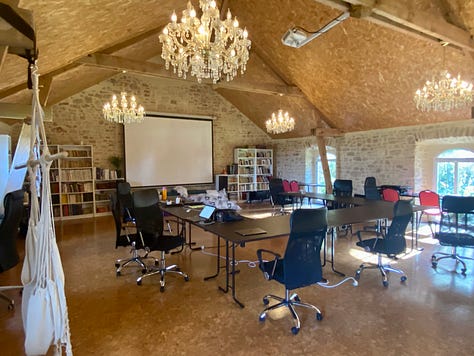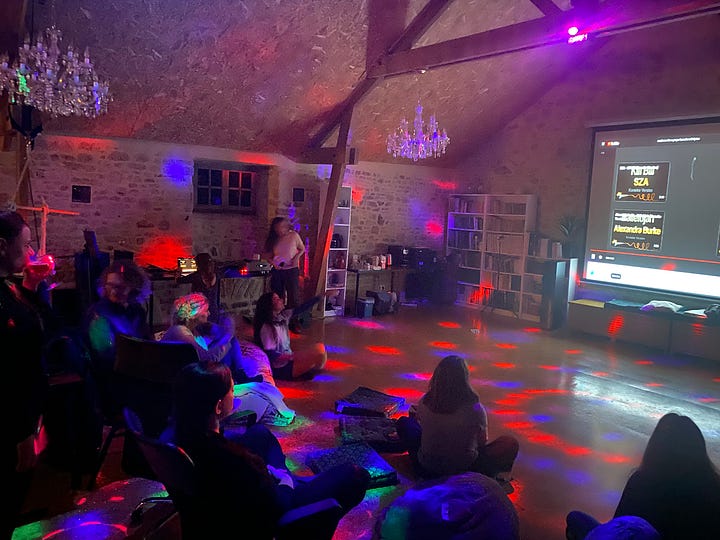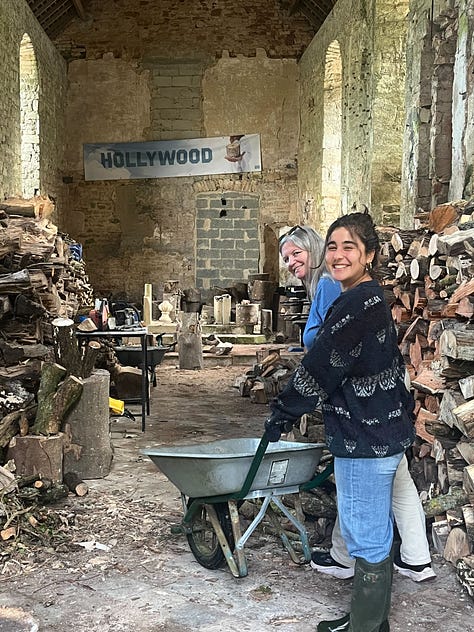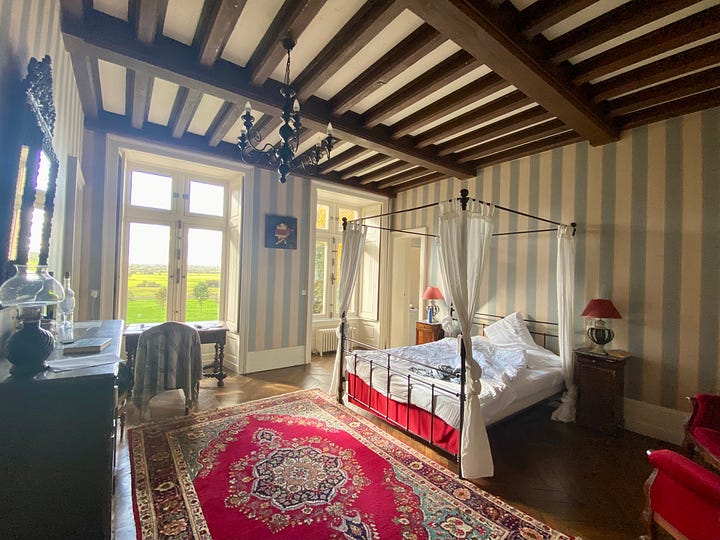Coliving Success: Building a Space and Community That Works, with Katia Dimova
What makes a coliving space truly work? Katia Dimova shares the mindset, systems, and community-first focus that have driven Chateau Coliving’s lasting success.

We’ve all had the Golden Girls fantasy, right? A shared house filled with laughter, quick banter over morning coffee, and the comforting knowledge that you’re never truly alone because your chosen family is just down the hall. It’s the dream that fuels a lot of coliving fantasies.
But what does it really take to build a space like that? And how do you turn it into something sustainable, welcoming, and well… livable for the longer term?
I don’t know about you, but I’ve had some coliving experiences that were just... off. When the shared spaces feel like an afterthought, the “community” is just a WhatsApp group, or the guest list seems more suited to a hostel than a home, you quickly lose the magic that makes coliving feel like a life you want to be living for any period of time.
And so, when I saw what’s happening at Chateau Coliving in Normandy, France, I wanted to dig in and see what’s going on behind the curtain.
I’ve spent time here this autumn with two separate groups and see a lot of things going right — more than in any other space I’ve stayed in, whether professionally organized or put together by friends:
Intentional guest selection that prioritizes alignment over occupancy
Thoughtfully designed shared spaces that invite connection without forcing it
Clear roles and systems that keep things running smoothly without micromanaging
A well-established community culture that welcomes newcomers without cliques
Founders, community managers, and housekeeping who are present but not overbearing, striking a good (and rare) balance of support and space
Events that feel organic, not obligatory, from shared meals to passion project demos
Now, these kinds of things don’t happen by accident. I sat down with Katia Dimova, the creative force behind Chateau Coliving, to learn more about the “secret sauce” behind her coliving’s success.
Here’s what I learned from our conversation about the real work behind it, and what you need to know if you’re dreaming of starting a coliving space of your own.
When Necessity Sparks Reinvention
Katia didn’t inherit a dreamy chateau and suddenly decide to invite the internet to come live with her. No… the Chateau’s origin story is one of pivoting fast, making bold decisions, and saying yes before everything was perfectly figured out.
The property had been operating as a luxury bed and breakfast (think Michelin-star meals and boutique hospitality), but the pandemic brought all of that to a screeching halt. With the place suddenly bleeding money, Katia and her husband found themselves in need of a radically different plan.
“We had to super quickly come up with an idea,” she told me. That idea? Turn the space into a coliving haven for digital nomads, inspired by the very lifestyle Katia herself had been living across Europe.
Her lockdown experience in a giant Spanish house with 15 people from different countries wasn’t just memorable; it planted the seed for what would eventually become Chateau Coliving.
The space wasn’t coliving-ready. Bathrooms had to be restructured. A community kitchen was a must. The top floor was completely unusable at first.
But here’s the thing Katia emphasizes: you don’t need a perfect space to get started — you need the right approach.
Building for Community, Not Hospitality Guests



“You can’t just let anyone book like it’s a hotel,” Katia told me. “Your community is the product.”
It’s a subtle but essential shift: filtering for fit is what makes coliving feel like home. Without that intentional curation, even the best-designed space can turn chaotic or uncomfortable.
Katia had seen what great coliving could look like. In addition to living in that Spanich coliving in Tenerife, she had worked there part-time, helping the owner with marketing while getting a close-up look at what made the space work.
Those experiences — both as a co-living resident and an experience-maker for them — gave her a grounded understanding of how to shape something more intentional than just shared accommodation.


It’s important to get outside of your own head and vision, to tap into the community you hope to serve, too, she says.
“Talk about your project early on,” Katia advises. “People want to feel like they’re part of it. Not just guests, but co-creators.”
From WhatsApp groups to Slack channels, Katia pulled from her global network of nomads and fellow founders to shape not just the physical renovations, but the ethos of the place. That early involvement helped build community before the first official guest ever arrived.
Where Coliving Founders Can Miss the Mark, Despite Their Best Intentions
Not all coliving is created equal. Katia has seen a clear split in how most projects take shape, and the pitfalls on both sides.
On one end, you’ve got the community-first dreamers. These are often people who fell in love with the coliving lifestyle and want to recreate it. They imagine dinner parties, deep connections, and maybe covering the mortgage along the way.
But there’s a catch: “What you love about coliving as a guest is that everything is taken care of for you,” Katia says. “When you’re the one running the space, it’s a whole different life.”
These founders often underestimate the admin, emotional labour, and logistics it takes to keep things running. They burn out… or worse, they start to resent the very people they invited in.
Having a team in place for support is essential. It’s the invisible things — the stocked pantry, clean bathrooms, the coffee that just shows up — that make coliving feel effortless, Katia says. But she cautions, “Those things don’t happen by magic. Someone is always doing that labour.



Boundaries can be a major issue for this type of founder, too.
“You become friends with your guests, which is beautiful… until it’s not,” Katia said. That blurred line between personal and professional is one of the hardest parts of coliving life. You’re living with your customers, and that requires boundaries, clear roles, and a whole lot of emotional intelligence.
On the other side are the business-first builders. These are typically developers or investors who see coliving as a growth market. They pour capital into sleek interiors and scalable systems, but forget that people aren’t just renting a room, they’re looking for a sense of belonging.
“It ends up feeling more like a serviced apartment than a shared life,” Katia explains. “You can have the nicest design in the world, but without community, it’s not coliving. It’s just co-habitating.”
Building More Than a Business: A Shared Vision for Coliving
Katia works to bridge that gap now through her consulting services. She helps community-first founders learn to run a sustainable business, and business-minded operators learn to create spaces where people feel truly seen and supported.
Because when either side is missing — heart or structure — the whole house wobbles.
One of the most refreshing things about talking with Katia is how clearly she sees the bigger picture. For her (and many of the most thoughtful founders in the space), coliving isn’t just about launching a personal project or turning a profit. It’s about helping shape a new way of living, working, and building community.
“We’re not just opening spaces,” she said. “We’re building an industry.”
And that matters. Because in an industry this new, every guest interaction, every shared dinner, every onboarding process becomes part of how people understand what coliving is.
That’s why collaboration trumps competition in this world. Katia and other founders regularly share insights, swap resources, and recommend other spaces when theirs is full. They know guests often stay a month or two, then move on — and if that next space drops the ball, it reflects on all of them.
“If someone has a bad experience, they don’t just think, ‘That place wasn’t for me.’
They think, ‘Coliving isn’t for me.’
And that hurts all of us,” Katia explained.
Just as colivers need spaces that support connection, founders need a strong support network, too. That’s why Katia leans on Slack groups, WhatsApp chats, and peer relationships with other founders across Europe and beyond.
It’s not just about solving plumbing emergencies or sharing marketing tips; it’s about not feeling alone in a role that can be deeply demanding, and learning lessons from one another before they take a toll on the business bank account.
This shared vision — a belief that coliving can be a globally connected, values-driven way of life — is what fuels her consulting work and community-building efforts.
It’s also part of what makes Chateau Coliving feel different: you’re not just renting a room, you’re stepping into something bigger. A movement. A prototype for what intentional living can look like in this next chapter.
Consulting for the Next Generation of Coliving Hosts
These days, Katia isn’t just running Chateau Coliving; she’s helping others start their own spaces through consulting. And her advice? Start early. Like, idea-is-still-a-scribble-in-your-notebook early.
“Even if we do just two sessions and decide it’s not for you, that clarity saves you time and money,” she explains.

She also challenges new hosts to get real about scale. “A lot of people say, ‘I just want five rooms,’ but that’s rarely enough to cover the work and cost.” Her advice is to run the numbers with someone who’s done it before, and don’t let romanticism override sustainability.
Her services range from feasibility studies and business planning to full community onboarding, including hosting your very first month with vetted guests to help kickstart momentum (and build out your photo library, testimonials, and social proof).
“We’ve helped launch spaces in totally unknown locations, even for owners with zero community and no nomadic background,” Katia says.
Her team fills the house, lives on-site, and trains hosts in real time. It’s a kind of coliving doula service that helps new projects get off to a healthy, confident start.
Running a coliving space means constant surprises — from unexpected plumbing issues in 200-year-old walls to community dynamics that evolve organically, no matter how much you plan.
“Sometimes we thought a cozy nook would be a reading corner, and the community decided it’s the game room,” Katia laughs. “You have to let the space breathe and evolve.”



Financially, many small-scale coliving projects struggle not because the concept doesn’t work, but because the business model isn’t solid. That’s why scale, systems, and realistic expectations matter just as much as vibe.
And if you’re wondering whether Katia gave up her nomadic lifestyle to build all this — she didn’t. She and her team work in rotation so they can stay connected to the road and the community they’re serving.
“I never really stopped traveling,” she says. “We want to keep that nomadic flavor alive.”
Thinking of Starting a Coliving Space?
Before you buy that charming villa or overhaul your family home, here’s what Katia wants you to know:
What You Really Need to Succeed:
A clear reason why you’re doing this (and a plan for what happens when reality kicks in).
A commitment to co-creating with your community, not just hosting them.
A willingness to treat coliving like the business it is — with systems, boundaries, and yes, an actual marketing plan.
A mindset that community building is not a hobby — it’s an emotional labor and leadership skillset.
The humility to ask for help early, especially from someone who’s been there.
Final Thoughts: Coliving Isn’t Just a Lifestyle; It’s a Calling


There’s a reason so many people daydream about opening a cozy shared living space somewhere beautiful. The idea of building community, offering connection, and living with purpose is powerful — especially for those of us rethinking how we want to live and work in this next chapter.
But like anything worth doing, it’s not easy.
Katia’s journey shows us that with the right mindset, strong systems, and a collaborative spirit, you can build something beautiful. Something lasting. Something that feels like home — even if that home is always evolving.
If that’s your dream, I highly recommend connecting with her. You can learn more about Chateau Coliving and her consulting services here.
If you’re looking to experience this place for yourself, I’ll be back at Chateau Coliving this February taking part in their Writers’ Haven program co-hosted by nomadic editor and publishing consultant Kristen Womble — and you can join, too.
It’s a month-long creative residency for writers, content creators, and curious humans who want to carve out space to create without going it alone. Check it out here and use booking code WRITERSFRIENDS for €200 off your rate.
Until then, may your wifi stay strong and your airport transfers arrive on time,
✌🏻 Miranda
P.S. What would your ideal coliving space look like? Have you ever considered starting one? Reply in the comments or share your thoughts in our Work From Anywhere group on Facebook.
You might also like:









